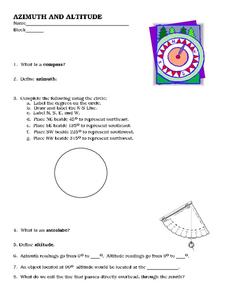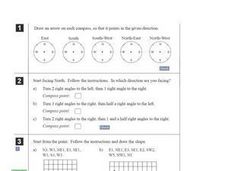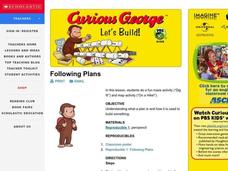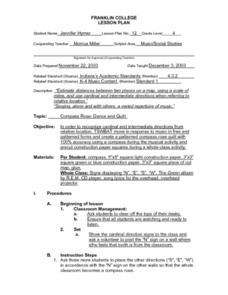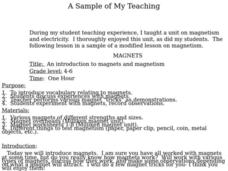Curated OER
Using Four Main Directions in the Classroom
Students identify the four cardinal directions. In this map skills geography lesson plan, students use a magnetic compass to label the four directions in the classroom. Students use the four directions to locate objects in the classroom.
Curated OER
Four Main Directions
Students describe directions using a globe for north, east, south and west. In this mapping activity students identify the north and south pole. Students understand the importance of the equator and the Prime Meridian. Students explain...
Curated OER
Using the Four Main Directions in the Classroom
Learners utilize a compass to determine where North is in the classroom. In this direction lesson plan, students label the four main directions. Learners locate features in the classroom and describe the directions to get to them....
Curated OER
Azimuth and Altitude
In this altitude worksheet, students define compass, azimuth, astrolabe, and altitude. Students use a protractor to determine the altitude of the given stars on a graph. This worksheet has 7 short answer questions and 8 fill in the blank...
Curated OER
Magnets
In this magnets worksheet, students review magnetic properties and define an electromagnet. This worksheet has 10 fill in the blank, 1 drawing, and 3 short answer questions.
Curated OER
Magnetic Earth
In this magnetic Earth worksheet, students learn how a compass works with the magnetic poles of the Earth. This worksheet has 4 short answer questions.
Curated OER
Compass Directions
In this compass activity, students solve 10 problems pertaining to compass directions. Students draw arrows on compasses according to the directions. Students also plot paths on grid paper, following directions given. This page is...
Curated OER
Forecasting Weather
In this weather activity, students conduct an experiment where they record the weather observations for a week. Then they determine the air pressure using an aneroid barometer and estimate the amount of sky covered by clouds. Students...
Curated OER
Magnetism
In this physics worksheet, students complete each of the statements with the correct word or phrase. Then they match each of the words listed on the left with their correct descriptions on the right.
Curated OER
Compass Points
For this math worksheet, 5th graders solve the ten questions that are related to degrees and compass directions. The answers are found on page 2.
Curated OER
Let's Build
Students observe and discuss a picture of Curious George building a bridge and discuss what it means to build, plan and design a project. As a class, they list things they need to do in oder to build something and explore how a compass...
Curated OER
So Many Inventions!
Students listen to a teacher read aloud of two books about Chinese inventions. They examine some items that were invented by Chinese inventors such as dominoes, an abacus, a silk scarf, or kite. Next, they determine how a compass works...
Curated OER
Naviagational Tools
Fifth graders create a compass, with the help of written instructions and then write six sentences discussing how compasses work and why they are helpful. They discuss the different types of navigational tools and how they are helpful.
Curated OER
Orienteering 2
Students are shown the basics of map and compass work. They name the parts of a compass and comprehend the function of each part. Students define paces and tallies and use them in a real world situation. They use a map and compass to...
Curated OER
Compass Rose: Dance and Quilt
Fourth graders identify the cardinal directions by listening to a song entitled, "Stand," and by reviewing the lyrics to that song. They notice the cardinal directions that are posted around the classroom. They perform the motions as...
Curated OER
ARE YOU A TRIANGULATEER?
Learners explore about triangles and their relationship to the worlld around them. They are able to identify triangular shapes in their environment. Students are able to communicate to one another their understanding of triangles outside...
Curated OER
What Pie?
Students practice making and interpreting pie graphs so they are better able to decide if a pie chart is the appropriate form of display. Students examine included overheads of different pie charts, and directions on how to make pie...
Curated OER
Motions and Forces
Sixth graders investigate the construction of a magnet and the force it produces. They identify various materials as magnetic or non-magnetic, discuss the properties of magnetic properties, and conduct an experiment with a compass and...
Curated OER
MAGNETS
Students identify magnetism and describe its meaning. Students discuss different types of magnets and list various ways magnets can be used. Students record observations of each magnet, like and different, and whether one has a larger...
Curated OER
Direction of River Flow
Students determine the direction the river flows. They use a US map with rivers listed, colored pencils and a compass or transparency with directions marked. Students use a color key to determine which direction the river is flowing...
Curated OER
TE Activity: The Trouble with Topos
Students study the uses of topographical maps including the many forms that they take. They discover that the map features show its intended use such as city maps, wilderness maps, and state maps. They complete a worksheet in which they...
Curated OER
Getting it Right!
Students investigate error. As shown in earlier activities from navigation lessons 1 through 3, without an understanding of how errors can affect position, one cannot navigate well. Students explore how computers can help in navigation....
Curated OER
Magnetic Mapping
Students draw arrows to show the direction the compass needle is pointing when it is placed around different points of a penny and a bar magnet. Students must then answer questions about the activity on a provided worksheet.
Curated OER
Native American Homelands
Students discuss the Navajo, Sioux, and Iroquois tribes, noting their distinctive characteristics. They trace the homeland of each of the tribes on maps and create map keys. Students explain how they developed their map keys.





